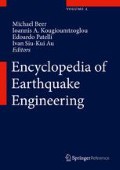Access this chapter
Tax calculation will be finalised at checkout
Purchases are for personal use only
References
An YK, Song HM, Park HJ, Sohn H, Yun CB (2012) Remote guided wave imaging using wireless PZT excitation and laser vibrometer scanning for local bridge monitoring. In: Bridge Maintenance, Safety, Management, Resilience and Sustainability: Proceedings of the Sixth International IABMAS Conference: 173, http://koasas.kaist.ac.kr/handle/10203/171481
An YK, Park B, Sohn H (2015) Complete noncontact laser ultrasonic imaging for automated crack visualization in a plate. Smart Mater Struct 22(2):025022
Castellini P, Maratarelli M, Tomasini EP (2006) Laser Doppler Vibrometry: development of advanced solutions answering to technology’s needs. Mech Syst Signal Process 20:1265―1285
Chang PC, Flatau A, Liu SC (2003) Review paper: health monitoring of civil infrastructure. Struct Health Monit Int J 2(3):257―267
Chatterjee K, Tuli S, Pickering SG, Almond DP (2011) A comparison of the pulsed, lock-in and frequency modulated thermography nondestructive evaluation techniques. NDT & E Int 44(7):655―667
Clark MR, McCann DM, Forde MC (2003) Application of infrared thermography to the non-destructive testing of concrete and masonry bridges. NDT&E International 36(4):265―275
Khan AZ, Stanbridge AB, Ewins DJ (2000) Detecting damage in vibrating structures with a scanning LDV. Opt Lasers Eng 32(6):583―592
Kim SB, Sohn H (2007) Instantaneous reference-free crack detection based on polarization characteristics of piezoelectric materials. Smart Mater Struct 16(6):2375
Li T, Almond DP, Rees DAS (2011) Crack imaging by scanning pulsed laser spot thermography. NDT & E Int 44(2):216―225
Liu W, Chen S, Boyajian D, Hauser E (2010) Application of 3D LiDAR scan of bridge under static loading testing. Mater Eval 68(12):1359―1367
Liu W, Chen S, Hauser E (2011) LiDAR-based bridge structure defect detection. Exp Tech 35(6):27―34
Nassif HH, Gindy M, Davis J (2005) Comparison of laser Doppler vibrometer with contact sensors for monitoring bridge deflection and vibration. NDT & E Int 38(3):213―218
Olsen MJ, Kuester F, Chang BJ, Hutchinson TC (2010) Terrestrial laser scanning-based structural damage assessment. J Comput Civ Eng 24(3):264―272
Park HS, Lee HM, Adeli H, Lee I (2007) A new approach for health monitoring of structures: terrestrial laser scanning. Comput Aided Civ Infrastruct Eng 22:19―30
Priestnall G, Jaafar J, Duncan A (2000) Extracting urban features from LiDAR digital surface models. Comput Environ Urban Syst 24(2):65―78
Rehor M (2007) Classification of building damage based on laser scanning data. Photogramm J Finl 20(2):54―63
Rehor M, Voegtle T (2008) Improvement of building damage detection and classification based on laser scanning data by integrating spectral information. Int Arch Photogramm Remote Sens Spat Inf Sci XXXVII(Part B7). Beijing, pp 1599―1606
Schweier C, Markus M (2006) Classification of collapsed buildings for fast damage and loss assessment. Bull Earthq Eng 4(2):177―192
Scruby CB, Drain LE (1990) Laser ultrasonics: techniques and applications. Adam Hilgher, Norfolk
Shen Y, Lixin W, Zhi W (2010) Identification of inclined buildings from aerial LIDAR data for disaster management. In: Proceedings of 18th international conference on geoinformatics, pp 1―5, http://ieeexplore.ieee.org/xpls/abs_all.jsp?arnumber=5567852&tag=1
Siringoringo DM, Fujino Y (2009) Noncontact operational modal analysis of structural members by laser Doppler vibrometer. Comput Aided Civ Infrastruct Eng 24:249―265
Vu TT, Matsuoka M, Yamazaki F (2004) LIDAR-based change detection of buildings in dense urban areas. In: Proceedings of IEEE international geoscience and remote sensing symposium, vol 5, pp 3413―3416, http://ieeexplore.ieee.org/xpls/abs_all.jsp?arnumber=1370438
Watson C, Chen S, Bian H, Hauser E (2012) Three-dimensional terrestrial LIDAR for operational bridge clearance measurements. J Perform Constr Facil 26(6):803―811
Wehr A, Lohr U (1999) Airborne laser scanning-an introduction and overview. ISPRS J Photogramm Remote Sens 54:68―82
Author information
Authors and Affiliations
Corresponding author
Editor information
Editors and Affiliations
Rights and permissions
Copyright information
© 2015 Springer-Verlag Berlin Heidelberg
About this entry
Cite this entry
Sohn, H., Park, B. (2015). Laser-Based Structural Health Monitoring. In: Beer, M., Kougioumtzoglou, I.A., Patelli, E., Au, SK. (eds) Encyclopedia of Earthquake Engineering. Springer, Berlin, Heidelberg. https://doi.org/10.1007/978-3-642-35344-4_86
Download citation
DOI: https://doi.org/10.1007/978-3-642-35344-4_86
Published:
Publisher Name: Springer, Berlin, Heidelberg
Print ISBN: 978-3-642-35343-7
Online ISBN: 978-3-642-35344-4
eBook Packages: EngineeringReference Module Computer Science and Engineering

